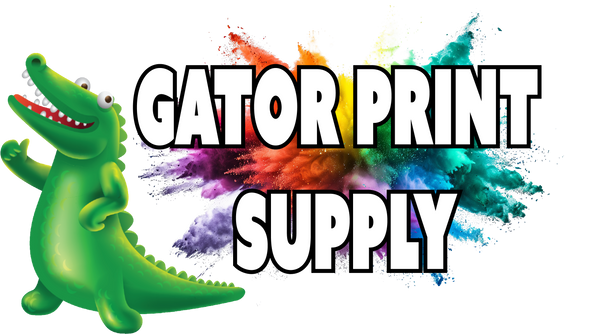Mastering the Art of Properly Curing Your DTF Transfers
Share
Achieving durable, high-quality Direct-to-Film (DTF) transfers goes beyond just printing and transferring onto your garment. One critical step that determines the longevity and appearance of your prints is proper curing. Improperly cured transfers can ruin an otherwise perfect design, causing issues such as poor adhesion, oily or spotty finishes, or even burnt ink. In this blog post, we’ll cover the importance of curing, the best equipment to use, and tips for achieving flawless results.
Why Curing Your DTF Transfers Matters
Curing DTF transfers is the process of heating the printed design so the ink and adhesive fully bond and solidify. This step ensures that your transfers adhere to garments properly and can withstand washing and wear. Curing involves applying the right temperature and time to activate the adhesive powder and cure the ink without damaging the print. Here’s why it’s essential:
-
Prevents Adhesion Issues
Undercured transfers may not stick to the fabric effectively, resulting in peeling or cracking over time. An undercured print will often feel oily to the touch, and you may notice white, spotty areas before peeling the film. -
Maintains Vibrant Colors
Overcuring your transfers can cause the ink to degrade, leading to a burnt appearance. Red inks, in particular, are susceptible to breaking down when overexposed to heat, which can turn your vibrant reds into dull, brownish tones. Yellowing of the transfer film is another telltale sign of overcuring. -
Ensures Durability
Properly cured transfers create a strong bond with the garment, making your prints long-lasting and resistant to wear and repeated washing.
Using High-Quality DTF Powder
In addition to proper curing, using a high-quality DTF powder is crucial. The adhesive powder plays a significant role in how well the transfer bonds to the garment and affects the print's overall durability. High-quality powders melt evenly and form a strong bond, while lower-quality powders may leave residue, create uneven adhesion, or affect wash resistance. Always invest in premium DTF powder to complement your ink and ensure optimal results.
Curing Equipment and Methods
-
Curing Ovens
Curing ovens are the most efficient and consistent way to cure DTF transfers. They provide even heat distribution and are easy to set at precise temperatures. These ovens allow you to cure multiple transfers simultaneously, speeding up production and improving efficiency. A curing oven is ideal for high-volume operations. -
Using a Heat Press
While it’s possible to cure transfers using a heat press, it’s not the most efficient method. The heat press requires extra care to ensure even curing across the entire design. You’ll need to hover the heat press (not press it down) just above the transfer film for a specific duration, typically between 2-3 minutes at around 300-325°F. This method is labor-intensive and less consistent compared to using a curing oven. -
Dryer Systems with Conveyors
For high-production environments, a conveyor dryer system is the best option. These systems streamline the curing process by automatically moving transfers through a heated tunnel. They are equipped with temperature controls and ventilation to ensure safe and efficient curing. Conveyor systems with proper ventilation are ideal for maintaining a steady production flow while ensuring all transfers are evenly and properly cured.
Safety Considerations: Ventilation and Fume Extraction
Curing DTF transfers generates fumes from the adhesive powder and ink. These fumes can be harmful if not properly ventilated, so safety should be a top priority. Here are some safety tips:
-
Use a Fume Extractor
A fume extractor captures and filters harmful particles and fumes, making your workspace safer. Proper ventilation is essential, especially when using curing ovens or conveyor dryers. It’s best to vent the fumes outside or use an industrial-grade air filtration system. -
Ensure Proper Airflow
Make sure your curing area has adequate airflow to avoid the buildup of fumes. A well-ventilated space will also help keep your equipment running efficiently and reduce the risk of overheating.
Signs of Properly Cured vs. Improperly Cured Transfers
-
Properly Cured Transfers
- The design adheres firmly to the film and has a smooth, even surface.
- There are no oily or wet spots visible, and the colors remain vibrant and true.
- The transfer peels cleanly without resistance.
-
Undercured Transfers
- The design may feel oily or have a wet appearance.
- White ink areas may look spotty or have visible powder that hasn’t melted.
- The transfer may peel poorly or not adhere well to the garment.
-
Overcured Transfers
- The film may become yellowed, particularly in areas exposed to too much heat.
- Ink colors, especially red, can degrade and appear burnt or brownish.
- The adhesive may become less effective, leading to peeling or cracking.
Balancing Temperature and Time
The optimal curing temperature and time depend on your specific setup and production speed. A common starting point is around 300-325°F for 2-3 minutes. However, every printer’s needs vary, and it’s important to test and adjust your settings based on your equipment and materials. High-volume operations may require faster speeds and conveyor systems, while smaller setups can adjust curing times accordingly.
Conclusion
Curing your DTF transfers properly is essential for achieving professional, long-lasting results. Whether you’re using a curing oven, a heat press, or a conveyor dryer system, paying attention to temperature, time, and safety will ensure your prints look vibrant and adhere securely to garments. Additionally, always use high-quality DTF powder to enhance adhesion and durability. For high-quality, efficient curing, investing in a dryer system with ventilation and a fume extractor is a wise choice that will elevate your DTF printing business. Remember: Cure right, print bright, and keep safety in mind!
